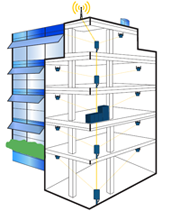 We all share a common problem at one point or another. Poor radio coverage! Whether Cell Phone, Two-Way Radio, Wi-Fi or Wireless Data, RF (Radio Frequency) Wireless signals for the most part have the same characteristics for signal propagation. Different frequencies penetrate buildings and structures in a manner that signal loss will occur. This means you have good coverage outside, but you may have marginal coverage inside. You have marginal coverage outside, but you may have no coverage inside.
We all share a common problem at one point or another. Poor radio coverage! Whether Cell Phone, Two-Way Radio, Wi-Fi or Wireless Data, RF (Radio Frequency) Wireless signals for the most part have the same characteristics for signal propagation. Different frequencies penetrate buildings and structures in a manner that signal loss will occur. This means you have good coverage outside, but you may have marginal coverage inside. You have marginal coverage outside, but you may have no coverage inside.
Building structures are made up of many different materials that either absorb RF or reflect RF. Either way a signal in the center of the building never seems to make it to you. You need to stand by the window in order to use your device.
Today’s solutions for signal loss in buildings or structures are far more advanced and lend itself to a seamless transition. 
Let’s go through the acronyms:
DAS – Distributed Antenna System, a network of radio frequency cables or fiber optic cables with antenna terminations throughout a building or structure.
BDA – Bi-Directional Amplifier – a radio that rebroadcasts RF Signals. Typically frequency specific for the RF Band needed.
BTS – Base Station – Head end equipment for Cellular carriers in building environments. It's similar to a cell site, but on a smaller scale.
When enhancing coverage in a building, we need to complete a site survey to determine where the signal is good and where the signal is bad. Typically at minimum we need the following:
- Frequency or Frequencies needed to be enhanced within the building or structure.
- Fire – 150Mhz or 800MHz
- Police – 150Mhz, 470Mhz, 800Mhz
- Cellular – 800Mhz, 900Mhz, 1.9GHz, (More to come)
- Wi-Fi – 2.4Ghz, 5.8Ghz
- Floor plan of the building or structure(s)
- Access to the roof or outside to obtain signal measurements from the assigned cellular or radio site.
- Approval from the Federal Communications Commission (FCC) license holder to rebroadcast the associated signals.
 It may sound challenging, but with the assistance of companies like Chicago Communications, all of the technical material is made simple. We arrive on site for a pre site walk discussion. We walk the building or structures to take readings with our instruments to determine signal strength within the confines of the building. We return to the office with the floor plans of the building and through software we model scenarios to insure coverage requirements from you the customer are met. Our designs are printed out in report form for review. A Bill of Materials is generated and a quotation is submitted to you the customer.
It may sound challenging, but with the assistance of companies like Chicago Communications, all of the technical material is made simple. We arrive on site for a pre site walk discussion. We walk the building or structures to take readings with our instruments to determine signal strength within the confines of the building. We return to the office with the floor plans of the building and through software we model scenarios to insure coverage requirements from you the customer are met. Our designs are printed out in report form for review. A Bill of Materials is generated and a quotation is submitted to you the customer.
The design may start with head end equipment such as a BDA required to enhance public safety frequencies in a building. The BDA is connected to a DAS system throughout the building. This DAS comes in two forms: RF Cable DAS or Fiber DAS. Depending on the size of the facility we will dictate the type of system. Fiber DAS is typically used in large venues as there is typically no loss associated with the Fiber systems. RF Cabled systems lose signal through the cable, so the design constraints are a bit more challenging.
Should multiple frequencies or Cellular Carriers be needed within the building, we have systems identified as Neutral Hosts that allow multi frequency systems to ride on one common DAS. The Neutral host combines all of the BDA or BTS Signals down to one common DAS.
Sounds complicated, maybe, but there are solutions. Contact us if you require enhancement to your building or structure.

This article was written by Tom Treichler, Operations Director of Sales & Service at Chicago Communications. Tom has over 30 years of experience in the industry with a background in engineering, system integration, and wireless broadband. If you have any questions for Tom, or another representative at ChiComm, please contact us.


